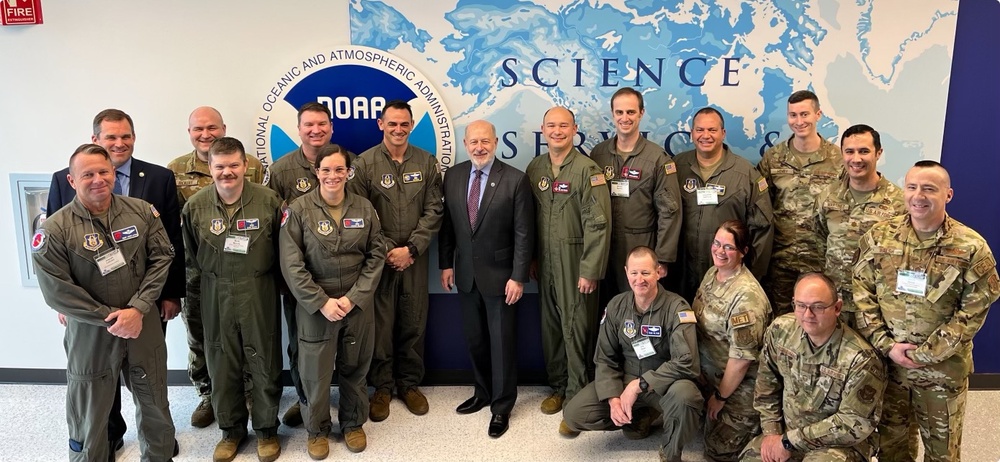DVIDS – News – 9th AS transport NOAA GOES-U weather satellite
KENNEDY SPACE CENTER, Fla. – Aircrew assigned to the 9th Airlift Squadron transported a National Oceanic and Atmospheric Administration Geostationary Operational Environmental Satellite, GOES-U, from Buckley Space Force Base, Colorado, to Kennedy Space Center, Florida, aboard a C-5M Super Galaxy, Jan. 23, 2024.
NOAA’s GOES-U is the fourth and final satellite in the GOES-R series, and is scheduled to launch in April 2024. GOES-U will be able to monitor severe weather, identify volcanic eruptions, measure land and sea surface temperatures, provide early alerts to emergency responders during wildfires and observe solar flares that could impact telecommunication on and around Earth.
“Once launched, the data it provides will touch the daily lives of anyone in the Western Hemisphere who checks the forecast,” said Lauren Duda, Lockheed Martin Space communications and media lead. “The high-quality weather data it captures also helps forecasters issue more timely severe weather warnings, which helps save lives and property. Every organization that helped get GOES-U to its launch site this week directly helped bring this important mission to reality.”
“The C-5M Super Galaxy, also built by Lockheed Martin, is the Air Force’s largest aircraft, and it’s extensive cargo bay size is the perfect fit for GOES-U’s school bus-sized trailer, plus ample ground support equipment,” said Duda. “Transporting GOES-U by aircraft is much safer than driving it for over 1,800 miles across the country.”
The mission showcases the C-5’s oversized carrying capacity and the aircrew’s ability to safely and efficiently transport the more than 11,000-pound weather satellite under unique restrictions.
“The biggest challenges were the onloading and offloading of the cargo, as well as the sensitivity once it was on board,” said Capt. Ryan Adams, 9th AS pilot. “Due to the size of the cargo, the clearances while on [and] offloading are extremely tight. The upload out of Buckley took roughly five hours and the download in Florida took roughly four hours.”
Adams explained an extra team of three loadmasters was necessary as they served as a dedicated upload crew while the other three remained in crew rest. Alternating load crews was a crucial part of the mission due to strict time constraints.
“Then there was a requirement once the cargo was on-board to maintain it at a certain temperature, which in the mid-30’s weather in Colorado was difficult,” said Adams. “We had one of our awesome flying crew chiefs stay at the jet after the upload was complete to run systems and monitor the temperature. Overall, it was a great effort by the entire crew.”
Transporting GOES-U brought unique challenges that tested the crew’s capabilities on moving a sensitive and rarely seen piece of cargo aboard the C-5.
“It is very rewarding and for me hands down the coolest mission I’ve been a part of,” said Adams. “As someone who grew up with an affinity for space and NASA, it was personally gratifying getting to fly a mission in conjunction with them along with Lockheed, NOAA and all the other agencies who had a hand in this movement. Also, the fact that a mission of this magnitude, getting GOES-U into space, wouldn’t be possible without the capabilities of the C-5M and the crew dogs of the 9th Airlift Squadron fills me with pride.”
| Date Taken: | 02.02.2024 |
| Date Posted: | 02.02.2024 10:14 |
| Story ID: | 463012 |
| Location: | KENNEDY SPACE CENTER, FL, US |
| Web Views: | 17 |
| Downloads: | 0 |
PUBLIC DOMAIN
This work, 9th AS transport NOAA GOES-U weather satellite, by SSgt Marco Gomez, identified by DVIDS, must comply with the restrictions shown on https://www.dvidshub.net/about/copyright.


 Private Internet Access gives you unparalleled access to thousands
of next-gen servers in over 83 countries and each US state. Your
VPN experience will always be fast, smooth, and reliable.
Private Internet Access gives you unparalleled access to thousands
of next-gen servers in over 83 countries and each US state. Your
VPN experience will always be fast, smooth, and reliable.
